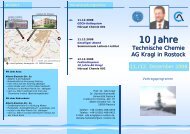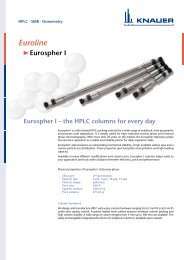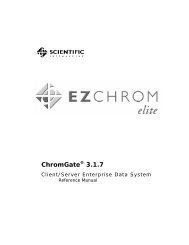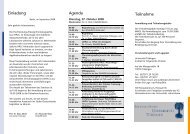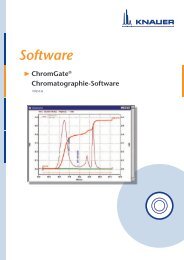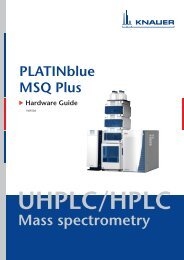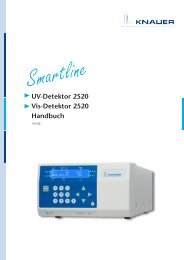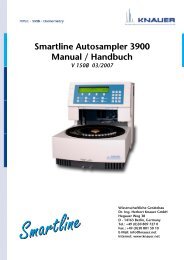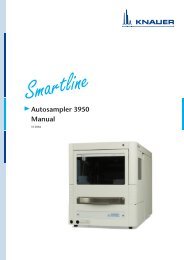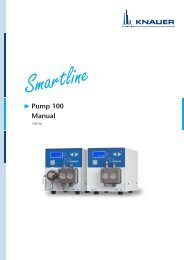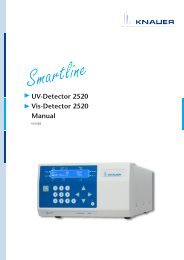Columns: Euroline care and use
Columns: Euroline care and use
Columns: Euroline care and use
- TAGS
- euroline
- www.knauer.net
You also want an ePaper? Increase the reach of your titles
YUMPU automatically turns print PDFs into web optimized ePapers that Google loves.
<strong>Euroline</strong><br />
� Column Care <strong>and</strong> Use<br />
1. Silica based phases<br />
Column Usage <strong>and</strong> Column Care<br />
The proper <strong>care</strong> of an HPLC column is extremely important for the lifetime of the<br />
column <strong>and</strong>, consequently, for the quality of your HPLC analysis. The following<br />
pages will give you some guidelines for the <strong>use</strong>, cleaning <strong>and</strong> storage of HPLC<br />
columns. These guidelines will depend on the nature of the chromatographic<br />
support (silica, polymers or others) <strong>and</strong> on the surface chemistry of the<br />
corresponding stationary phase.<br />
General guidelines<br />
Silica is the ideal support for HPLC columns. It offers good mechanical stability,<br />
excellent physicochemical surface properties, a wide range of bonding chemistry<br />
<strong>and</strong> is compatible with a broad range of organic solvents. However, the following<br />
points are extremely important when working with silica based HPLC columns.<br />
pH stability<br />
Mechanical stability<br />
In general silica based HPLC columns are stable within a pH range of 2 to 8. When<br />
measuring pH, the measurement should be done in the aqueous media before<br />
mixing the eluent with organic solvents. This will give a more accurate <strong>and</strong><br />
consistent measurement of pH than taking a measurement in a mixed<br />
aqueous/organic media. Some modern HPLC columns can be <strong>use</strong>d outside that pH<br />
range. New bonding chemistry allows for operating as low as pH 1 with some<br />
stationary phases. However, you should check vendors product information first<br />
before using a silica based column outside the pH range of 2 to 8. Stationary phases<br />
based on ultra pure silica gel can also be <strong>use</strong>d at a pH as high as 11, depending on<br />
the chemical nature of the modifier <strong>use</strong>d in the mobile phase. Large bases (such as<br />
pyrolidine) are not able to attack the surface of the silica <strong>and</strong>, therefore, can be <strong>use</strong>d<br />
as mobile phase modifiers when higher pH values are required. If you are working at<br />
pH values above 8 using small bases as the modifier (such as ammonia), we highly<br />
recommend using stationary phases based on polymers or zirconium dioxide.<br />
Stationary phases based on silica are mechanically very stable, <strong>and</strong> well-packed<br />
columns can be <strong>use</strong>d at more than 40 MPa (6000 psi) without any problem.<br />
However, pressure shocks to the column should be avoided. Pressure shocks can<br />
lead to channeling in the bed column, which may result in peak splitting in the<br />
corresponding chromatogram.<br />
Mobile phases (eluents)<br />
Silica based stationary phases are compatible with all organic solvents in the above<br />
mentioned pH range. For best results, the highest quality solvents available, such as<br />
HPLC grade solvents, should be <strong>use</strong>d. Also, all prepared buffers should be filtered<br />
through a 0.45 µm filter before using them in your HPLC system. Always keep in<br />
mind that your column will collect any particulate material that enters the flow<br />
stream. The <strong>use</strong> of non-pure solvents in HPLC ca<strong>use</strong>s irreversible adsorption of<br />
impurities on the column head. These impurities block adsorption sites, change the<br />
selectivity of the column <strong>and</strong> eventually lead to peak splitting in the chromatogram.
In gradient elution, they ca<strong>use</strong> so-called "ghost peaks". "Ghost peaks" are peaks that<br />
always appear at the same position in the chromatogram. Their origin is not the<br />
sample, but the impurities from the solvents or solvent additives. Therefore, it is highly<br />
recommended to run a gradient without injecting a sample at the beginning of each<br />
method to determine if ghost peaks will be a problem. To avoid irreversible<br />
adsorption at the head of the column, you should always <strong>use</strong> a precolumn. The <strong>use</strong> of<br />
a precolumn increases the lifetime of a column dramatically. In addition to that, a<br />
precolumn can filter particulate material coming from pump seals or injection rotors.<br />
An alternative to a precolumn is an in-line filter. These filters are placed between the<br />
column <strong>and</strong> the injector <strong>and</strong> newer versions can be mounted directly on columns.<br />
These filters are great for removing particulate material from the eluent, but they will<br />
not take the place of precolumns by removing organic impurities that may irreversibly<br />
adsorb to the column.<br />
Proper storage of silica based HPLC columns<br />
• For short-term storage, i.e. overnight, columns can be stored in the eluent.<br />
Equilibration time<br />
• For middle term storage, i.e. 2 days or over the weekend, columns should be<br />
flushed with pure water to prevent algal growth.<br />
• For long term storage, silica based columns should be stored in an aprotic<br />
solvent. The water content should not be greater than 50%. The best solvent for<br />
storage is acetonitrile.<br />
• Caution! Make sure that all buffers are washed out of the column before<br />
exchanging aqueous mobile phases by organic solvents. Buffer salts are not<br />
soluble in acetonitrile <strong>and</strong> can block capillary tubing <strong>and</strong> the column.<br />
The equilibration time of a column depends on the column dimensions. In general, a<br />
column is equilibrated after 20 column volumes are flushed through it. The<br />
equilibration times for the most important column dimensions are summarized in the<br />
following table.<br />
You can reduce the equilibration time by simply increasing the flow rate. However,<br />
make sure to flush the column with at least 20 column volumes to make sure the<br />
column is equilibrated.<br />
Column Dimension Column Volume Flow Rate Equilibration Time<br />
[ml] [ml/min] [min]<br />
250 x 4.6 mm 2.91 1.00 58<br />
150 x 4.6 mm 1.74 1.00 35<br />
100 x 4.6 mm 1.16 1.00 23<br />
50 x 4.6 mm 0.58 1.00 12<br />
250 x 4.0 mm 2.20 1.00 44<br />
125 x 4.0 mm 1.10 1.00 22<br />
250 x 2.0 mm 0.55 0.25 44<br />
150 x 2.0 mm 0.33 0.25 26<br />
50 x 2.0 mm 0.11 0.25 9<br />
Regeneration of a column<br />
Impurities from the sample or mobile phase can adsorb to the head of a column <strong>and</strong><br />
ca<strong>use</strong> changes in selectivity or peak splitting. Often these "dirty columns" can be<br />
regenerated by applying the following protocols:
Regeneration of RP packings<br />
Regeneration of NP packings<br />
C18, C8, C4, C1, C30, CN <strong>and</strong> Phenyl stationary phases:<br />
• Flush the column with 20 column volumes of water<br />
• Flush the column with 20 column volumes of acetonitrile<br />
• Flush the column with 5 column volumes of isopropanol<br />
• Flush the column with 20 column volumes of heptane<br />
• Flush the column with 5 column volumes of isopropanol<br />
• Flush the column with 20 column volumes of acetonitrile<br />
Silica, Diol, Nitro <strong>and</strong> Amino stationary phases:<br />
• Flush the column with 20 column volumes of heptane<br />
• Flush the column with 5 column volumes of isopropanol<br />
• Flush the column with 20 column volumes of acetonitrile<br />
• Flush the column with 20 column volumes of water<br />
• Flush the column with 20 column volumes of acetonitrile<br />
• Flush the column with 5 column volumes of isopropanol<br />
• Flush the column with 20 column volumes of heptane<br />
Regeneration of Ion Exchange Packings<br />
2. Polymer based Phases<br />
General guidelines<br />
Anion <strong>and</strong> Cation exchange (WCX, SCX, WAX <strong>and</strong> SAX):<br />
• Flush the column with 20 column volumes of the same eluent,<br />
• but double the buffer concentration<br />
• Follow the regeneration protocol for RP packings (see above)<br />
• Flush the column with 20 column volumes of water<br />
• Equilibrate the column with the original conditions<br />
Polymer based stationary phases show a higher pH stability but a lower mechanical<br />
stability compared to silica based columns. Also polymer based packings are not<br />
compatible with all organic solvents. They will swell or shrink in some organic<br />
solvents. Unfortunately, the pressure stability <strong>and</strong> solvent compatibility are not only<br />
different for the different types of polymers, they are also different from manufacturer<br />
to manufacturer. Therefore, no general rules for the <strong>care</strong> of polymer based materials<br />
can be given. Always read the instructions for the <strong>use</strong> of those columns. In case of<br />
doubt, please contact the corresponding manufacturer. Nevertheless, general<br />
guidelines do exist for the storage <strong>and</strong> regeneration of the different types of polymer<br />
supports.<br />
Storage guidelines for polymer based columns<br />
• Hydrophobic unmodified polystyrene-divinylbenzene (PS-DVB, e.g. Hamilton PRP-1):<br />
These types of columns can be stored for long periods analogously to silica based<br />
columns, that is, in an aprotic solvent. The best solvent for storage of these<br />
columns is acetonitrile.
Visit www.knauer.net for details on complete HPLC systems, HPLC columns, <strong>and</strong> osmometers<br />
Wissenschaftliche Gerätebau Your local distributor<br />
Dr. Ing. Herbert Knauer GmbH<br />
Hegauer Weg 38<br />
14163 Berlin, Germany<br />
Telephone: +49 (0)30 809727-0<br />
Telefax: +49 (0)30 8015010<br />
E-Mail: info@knauer.net<br />
Internet: www.knauer.net<br />
• Polymer based ion exchangers<br />
(e.g. Eurokat H, CarbEx H-Form or Hamilton PRP- X 100):<br />
These types of columns must not be treated with organic solvents in high<br />
concentrations. For storage we recommend a 0.01% aqueous sodium azide<br />
solution. Storing these columns at 4°C (i.e. refrigeration) also helps to prevent<br />
algal growth.<br />
Regeneration of polymer materials<br />
When a column exhibits a change in selectivity or always shows a double peak at a<br />
particular retention time, the ca<strong>use</strong> is frequently the strong adsorption of a matrix<br />
component. Generally these types of contaminated columns can be regenerated by<br />
one of the methods given below. Specific regeneration methods must be <strong>use</strong>d for<br />
different types of polymer columns. Appropriate regeneration methods for specific<br />
polymer based columns are described below.<br />
• Hamilton PRP-1, PRP-3, PRP-Infinity<br />
Rinse the column with 20 column volumes of water<br />
Run a linear gradient from 100% water to 100% acetonitrile<br />
Repeat the procedure 3 times<br />
• Hamilton PRP X-100<br />
Rinse the column with 20 column volumes of water<br />
Rinse the column with 20 column volumes of methanol with 1% 6 N nitric acid<br />
• Hamilton PRP X-200, PRP X-300<br />
Rinse the column with 20 column volumes of water<br />
Inject 100 µl of 1 N nitric acid, 5 times consecutively<br />
• Hamilton RCX-10<br />
Rinse the column with 20 column volumes of a 0.1 N sodium hydroxide solution<br />
• Hamilton RCX-30<br />
Rinse the column with 60 column volumes of a 0.1 N sodium hydroxide solution<br />
• Eurokat H, CarbEx H-Form, Hamilton HC-75 Hydrogen Form<br />
Rinse the column for 4 to 6 hours with 0.05 N sulphuric acid at 60 °C, using a<br />
flow rate of 0.2 ml/min<br />
• Eurokat Ca, CarbEx Ca-Form, Hamilton HC-75 Calcium Form,<br />
Hamilton HC-40 Calcium Form<br />
Rinse the column for 4 to 6 hours with a 0.25 M calcium nitrate solution at<br />
60 °C, using a flow rate of 0.2 ml/min<br />
• Eurokat Pb, CarbEx Pb-Form, Hamilton HC-75 Lead Form<br />
Rinse the column for 4 to 6 hours with a 0.25 M lead nitrate solution at 60 °C,<br />
using a flow rate of 0.2 ml/min




